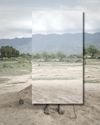
But, arriving in the northeast of Niger, Sereno and his colleagues day after day sifting through the sand of Tenere desert, one of the most inhospitable deserts in the world, which even the nomadic inhabitants of the Sahara called "desert in the desert."
There were practically no finds. In the evening on the last day of the excavation, the scientists were about to leave, and most of them went to the camp, but Sereno still insisted that his team get to a distant hill, promising their employees that the expedition was on this hill. Sereno fulfilled his promise, but the end of that expedition was the beginning of great new work: on the way to the hill, scientists found a whole stone age cemetery.
Human bones, H perfectly -preserved in African sand, stick out directly from the ground, paleontologist and their archaeologist noticed from the car, approaching the cemetery. For the first time in 2003, scientists returned to Niger, in the Gobero region, and over the past five years, they found about 200 Stone Age graves. It is the results of the study of these 67 burials and the numerous bones and artefacts found both in these graves and in their environs. As it turned out, the bones of people belonging to two cultures at once lie in Gobero.
The first about ten thousand years ago came here tribes of strong people, hunters, and fishers, which scientists attributed to the Kiffian culture. Just two millennia earlier, the last ice age ended, the Earth entered the Holocene, and the Sahara, which remained a dry desert for many thousands of years, was filled with water and life.
Bu hikaye Lens Magazine dergisinin September 2022 sayısından alınmıştır.
Start your 7-day Magzter GOLD free trial to access thousands of curated premium stories, and 9,000+ magazines and newspapers.
Already a subscriber ? Giriş Yap
Bu hikaye Lens Magazine dergisinin September 2022 sayısından alınmıştır.
Start your 7-day Magzter GOLD free trial to access thousands of curated premium stories, and 9,000+ magazines and newspapers.
Already a subscriber? Giriş Yap

IN THE SHIPYARDS OF DHAKA
A very large shipyard in Dhaka is located on the Buriganga River's banks, directly across Dhaka's old city.

Aga Szydlik INDIA
A JOURNEY INTO THE LAND OF DIVERSITY, CULTURE, AND COLORS

SEBASTIAN PIÓREK EXPLORING Enjoyable LANDSCAPE
I retrieved the idea of nature closely linked to the field of human feelings.

The Extreme Macro Photography of Bees
AN INTERVIEW SAM WITH, DROEGE

JEAN KAROTKIN GYMNOPEDIES
Gymnopédies, Karotkin's ongoing series of botanical portraits, takes its name from a trio of piano compositions by 19th-century French composer Erik Satie.

BUTTERFLIES IN LOVE WITH FLOWERS
I sometimes think Chinese art is not fully appreciated in the West. I was exposed to it growing up in Australia, although my fascination was more with calligraphy.

Lissa Hahn:
Hahn: HOW TO EVOKE A PAVLOVIAN RESPONSE IN HUMANS

AN EXCLUSIVE INTERVIEW WITH ELENA PARASKEVA
Elena Paraskeva is an internationally acclaimed, award-winning Conceptual Photographer and Art Director and, most recently, an official ADOBE instructor.

From a Living Hell to Heaven on Earth: the Inhumanity and Humanity of Humans
In a remote area of western Wisconsin, dogs and cats who otherwise would have ended up on death row are given a reprieve. They can now live out their lives in peace and comfort and with companionship at Home for Life (HFL), which was not afforded them outside the sanctuary's gates.

The Art of DISAPPEARING
In the classical proposal, indigenous people are usually the topic of discussion, but rarely do they have a hand in shaping it.